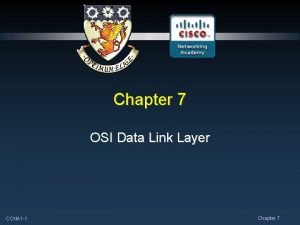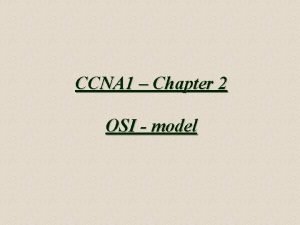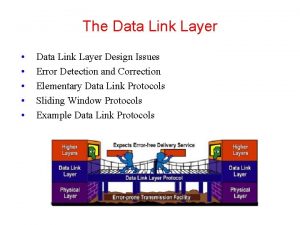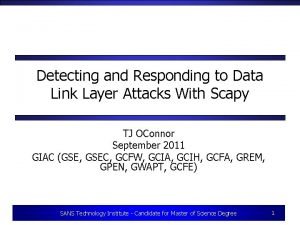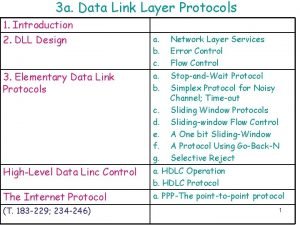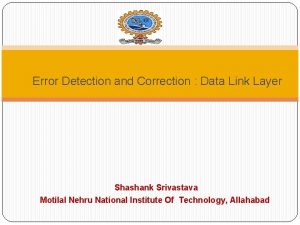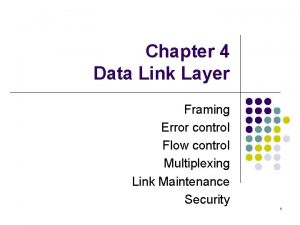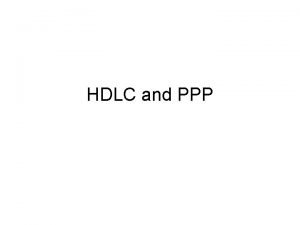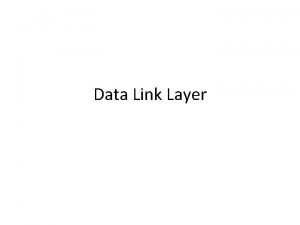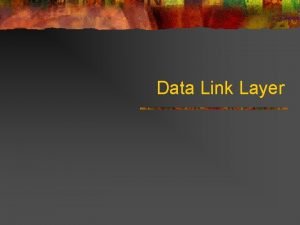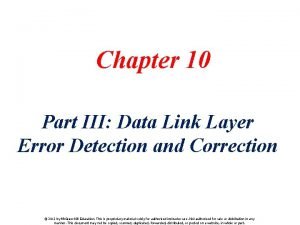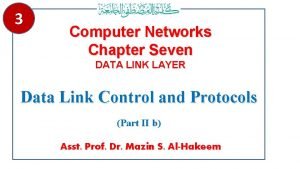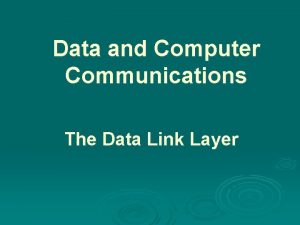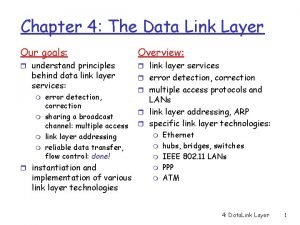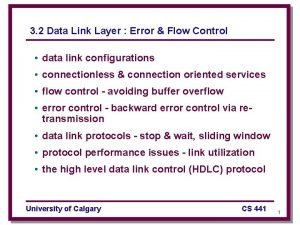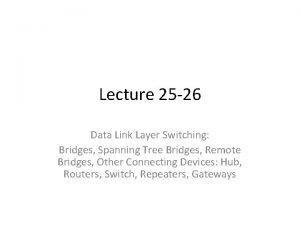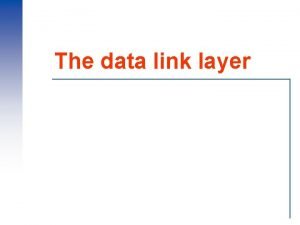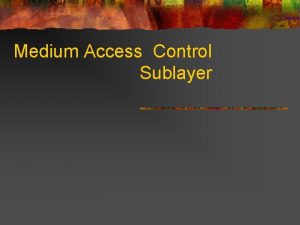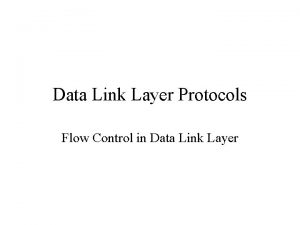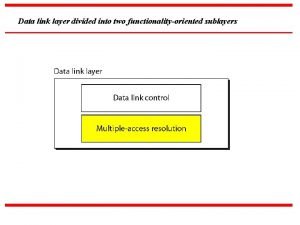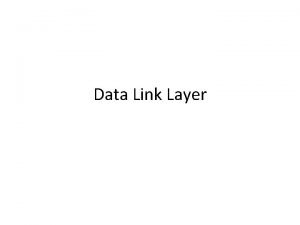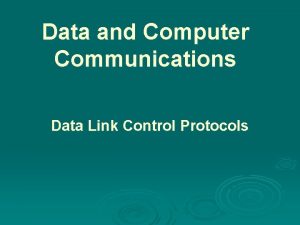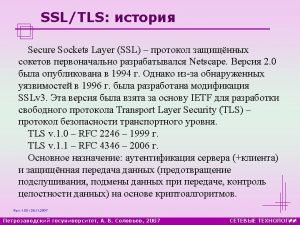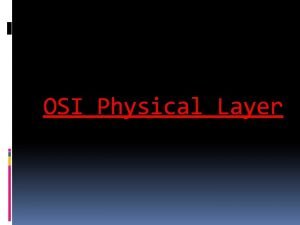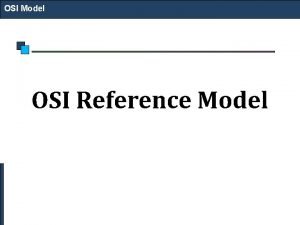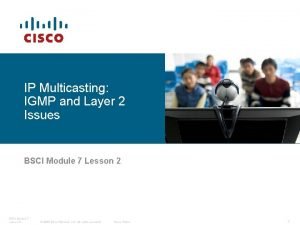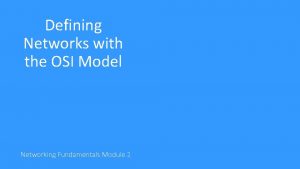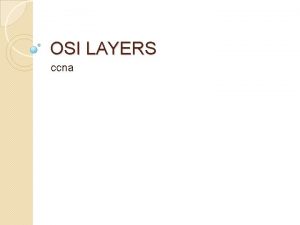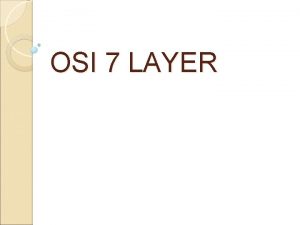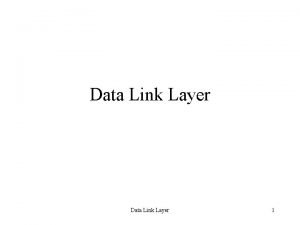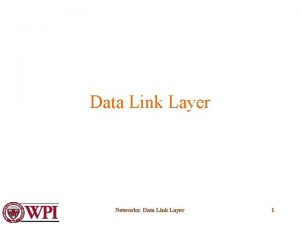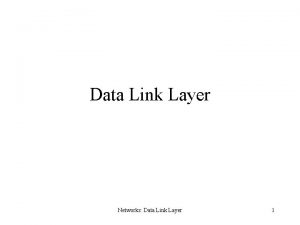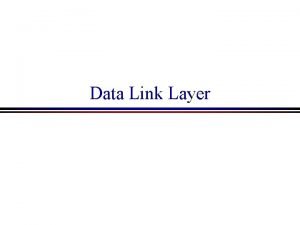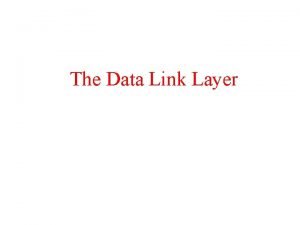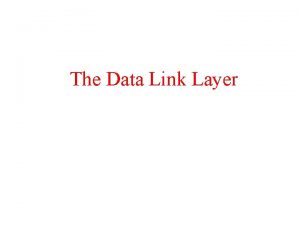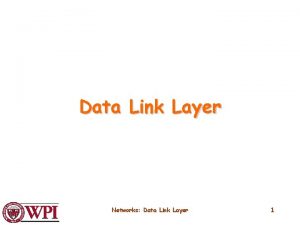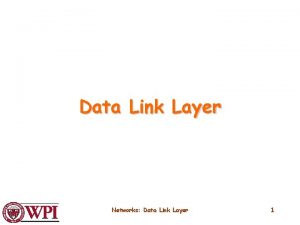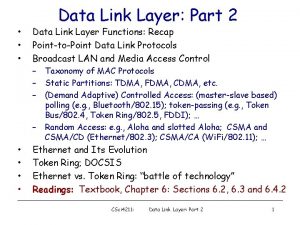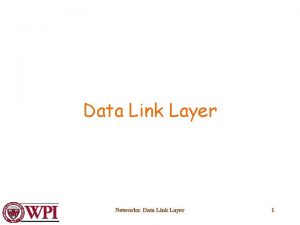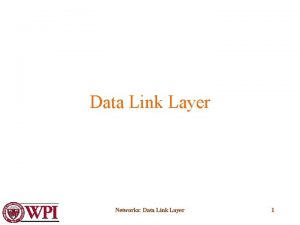Chapter 7 OSI Data Link Layer CCNA 1




































- Slides: 36

Chapter 7 OSI Data Link Layer CCNA 1 -1 Chapter 7

Note for Instructors • These presentations are the result of a collaboration among the instructors at St. Clair College in Windsor, Ontario. • Thanks must go out to Rick Graziani of Cabrillo College. His material and additional information was used as a reference in their creation. • If anyone finds any errors or omissions, please let me know at: • tdame@stclaircollege. ca. CCNA 1 -2 Chapter 7

OSI Data Link Layer Accessing the Media CCNA 1 -3 Chapter 7

OSI Data Link Layer Provides the user interface Organize data for network transfer CCNA 1 -4 Segmentation and managing communications Exchange data over common media Chapter 7

Supporting and Connecting to Upper Layer • Two basic functions: • Allows the upper layers to access the media using framing. • Controls how data is placed on the media and received from the media using media access control (MAC) and error detection. CCNA 1 -5 Chapter 7

Supporting and Connecting to Upper Layer Terminology CCNA 1 -6 Chapter 7

Supporting and Connecting to Upper Layer Protocol governs how to format a frame for use on that media Different protocols for different media Accept the frame Decapsulate to a packet Construct a new frame for the media Forward the new frame CCNA 1 -7 Chapter 7

Controlling Transfer Across Local Media • Layer 2 protocols specify the encapsulation of a packet into a frame and the techniques for getting the encapsulated packet on and off each media. • The technique is termed the Media Access Control (MAC) method. • Different media might require a different MAC method. • Each media type encountered can have different characteristics. (Especially a router where several different media types can co-exist. ) CCNA 1 -8 Chapter 7

Controlling Transfer Across Local Media WAN Header LAN Header WAN Trailer Packet LAN Trailer Different media… Different characteristics… Different MAC method… CCNA 1 -9 Chapter 7

Controlling Transfer Across Local Media The protocol can be configured on the device and determines the type of encapsulation (MAC method). Different media… Different characteristics… Different MAC method… CCNA 1 -10 Chapter 7

Creating a Frame • The description of a frame is the key element of each protocol. • Different protocols require different information to function properly. • Which nodes are in communication with each other. • When communication between individual nodes begins and when it ends. • Which errors occurred while the nodes communicated. • Which nodes will communicate next. CCNA 1 -11 Chapter 7

Creating a Frame • Frames travel the media as a stream of bits. • The framing of the packet inserts control information in specific fields……MORE DETAILS LATER…. . CCNA 1 -12 Chapter 7

Connecting Upper-Layer Services to the Media Network devices have both a hardware and software component. CCNA 1 -13 Chapter 7

Connecting Upper-Layer Services to the Media • Data Link Layer prepares the packets from the upper layer software processes for transmission over the physical media. CCNA 1 -14 Chapter 7

Standards • Not defined by RFCs as in the other layers. • Defined by engineering organizations. CCNA 1 -15 Chapter 7

Connecting Upper-Layer Services to the Media IEEE Logical Link Control (LLC) Sub-Layer Frames the network layer packet Identifies the network layer protocol Media Access Control (MAC) Sub-Layer Addresses the frame Marks the beginning and end of the frame CCNA 1 -16 Chapter 7

Placing Data on the Media • Regulating the placement of data on the media is termed Media Access Control. Media sharing: If and how the nodes share the media. Topology: How the connection appears to the Data Link Layer. CCNA 1 -17 Chapter 7

MAC for Shared Media • Two Basic Methods: More in Chapter 9 CCNA 1 -18 Chapter 7

MAC for Non-Shared Media • Point-to-Point Connections: Type of communication. Half Full. Duplex CCNA 1 -19 Chapter 7

Logical Topology vs Physical Topology • Physical Topology: • Arrangement of the nodes and the physical connections between them (More in Chapter 9). • Logical Topology: • The way a network transfers frames among nodes. The use of virtual connections between the nodes regardless of the actual physical connection. • Point-to-Point • Multiaccess • Ring CCNA 1 -20 Chapter 7

Point-to-Point Logical Topology • Concerned with full or half duplex. CCNA 1 -21 Chapter 7

Multiaccess Logical Topology • Enables a number of nodes to communicate using the same shared media. A sends to E Check for other transmissions Media available Transmit X X X I’ll wait…… Media NOT available B needs to send to D CCNA 1 -22 Check for other transmissions Chapter 7

Ring Logical Topology • Each node receives a frame in turn. If it is not addressed to the node, it passes it on. Is it for me? Yes No Is it for me? A sends to D Is it for me? CCNA 1 -23 No Chapter 7

OSI Data Link Layer Addressing and Framing Data CCNA 1 -24 Chapter 7

The Frame • There are many different Data Link Layer protocols…. • The Data Link Layer protocol describes the features required for the transport of frames. • Integrated into the encapsulation process. • No single frame protocol meets the needs of all data transportation across all types of media. CCNA 1 -25 Chapter 7

The Frame • However, each Data Link Layer protocol is constructed using the same basic format. • It’s the contents that differ…. Header CCNA 1 -26 Data Trailer Chapter 7

Framing: Role of the Header • Contains the control information required by the protocol. • Some sample fields…… • Start of Frame • Source and Destination MAC Addresses • Priority/Quality of Service • Type/Length • Logical Connection Control • Physical Link Control • Flow Control • Congestion Control CCNA 1 -27 Chapter 7

Framing: Role of the Header Specific bit sequence that indicates to the receiving device that the frame starts here. Header Start Address Type/Length The source and destination MAC addresses. CCNA 1 -28 For example: Data Trailer A code identifying the type of frame OR the total length of the frame. Chapter 7

Addressing: Where the Frame Goes • The addresses used this layer are referred to as physical addresses. • They are the burned-in MAC addresses of the network device (PC: NIC, Router: Physical port). • They are only used for local delivery. • If the frame must be transported to another segment, the frame is re-encapsulated by the receiving device and forwarded. Header Start CCNA 1 -29 Address Type/Length Data Trailer Chapter 7

Addressing: Where the Frame Goes OR send as a broadcast • The Data Link Layer protocol will define the addressing required to move the frame through the network. CCNA 1 -30 Chapter 7

Framing: Role of the Trailer Frame Check Sequence (FCS): Used to provide basic error checking, usually with a Cyclic Redundancy Check (CRC). - Sending device uses an algorithm on the bits of the header and data portions. - The resulting value is placed in the FCS field. - Receiving device does the same thing. - If the values match – no error. - If the values do not match – frame discarded. Header Data Trailer FCS Stop A specific sequence of bits that indicate the end of the frame. CCNA 1 -31 Chapter 7

Sample: Data Link Layer Frames Point-to-Point Protocol (PPP) High Level Data Link Control Protocol (HDLC) Frame Relay Protocol Ethernet Protocol CCNA 1 -32 Chapter 7

Ethernet Protocol for LANs CCNA 1 -33 Chapter 7

Point-to-Point Protocol for WANs CCNA 1 -34 Chapter 7

Wireless Protocol for LANs CCNA 1 -35 Chapter 7

Putting It All Together Both the text and the online curriculum follow a packet from the source to the destination. Text: Pages 267 – 262 Curriculum: Section 7. 4. 1 CCNA 1 -36 Chapter 7
 What is a function of the data link layer ccna
What is a function of the data link layer ccna Yang termasuk fungsi data link layer adalah
Yang termasuk fungsi data link layer adalah Osi model ccna
Osi model ccna Data link layer design issues
Data link layer design issues Materi data link layer
Materi data link layer Deauth attack
Deauth attack Fungsi data link layer
Fungsi data link layer Switching in data link layer
Switching in data link layer Stop-and-wait arq
Stop-and-wait arq Data link layer design issues in computer networks
Data link layer design issues in computer networks Error detection and correction in data link layer
Error detection and correction in data link layer Data link layer design issues
Data link layer design issues Error control in data link layer
Error control in data link layer Hdlc categories
Hdlc categories Communication at the data link layer is
Communication at the data link layer is Design issues of data link layer
Design issues of data link layer Error detection methods in data link layer
Error detection methods in data link layer Data link layer protocols for noisy and noiseless channels
Data link layer protocols for noisy and noiseless channels Responsibilities of data link layer
Responsibilities of data link layer Data link layer
Data link layer Dlc in data link layer stands for
Dlc in data link layer stands for Link
Link Data link layer flow control
Data link layer flow control The two main functions of the data link layer are
The two main functions of the data link layer are Data link layer switching
Data link layer switching Data link layer design issues
Data link layer design issues Channel allocation problem in medium access sublayer
Channel allocation problem in medium access sublayer Flow control in data link layer
Flow control in data link layer Data link sublayers
Data link sublayers Data link layer framing
Data link layer framing Flow control protocols in data link layer
Flow control protocols in data link layer Osi rm
Osi rm What is the purpose of the osi physical layer
What is the purpose of the osi physical layer Physical layer in osi model examples
Physical layer in osi model examples Dedicated line
Dedicated line Igmp osi layer
Igmp osi layer Which layer in the osi model covers http, ftp, and rdc?
Which layer in the osi model covers http, ftp, and rdc?
